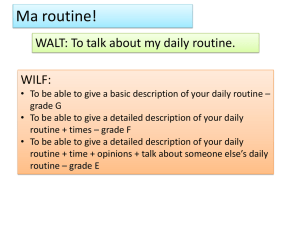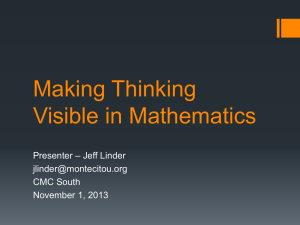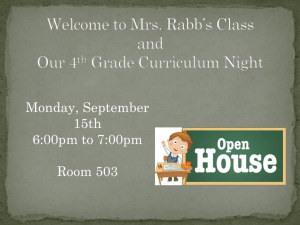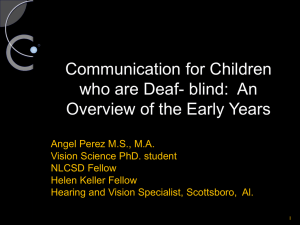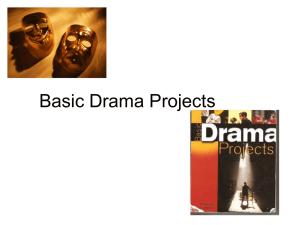Instructional Strategies for Teaching Learners who are Deaf
advertisement
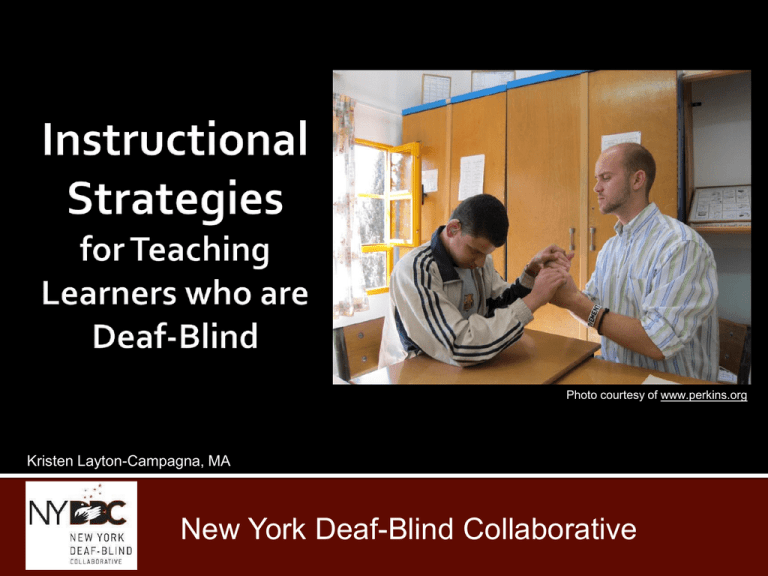
Photo courtesy of www.perkins.org Kristen Layton-Campagna, MA New York Deaf-Blind Collaborative Learner objectives: SP.05.h: Facilitate s child’s/youth’s participation in the entire activity to the fullest extent possible. SP.05.i: Understands the impact of the child’s/youth’s developmental level on designing and implementing intervention and instruction SP.05.j: Develops systematic instructional activities and materials that are meaningful, relevant, and age appropriate SP.05.za: Uses routine or activity based instruction to enhance learning SP.05.zh: Task analyzes specific activities SP.05.zj: Uses graduated prompting procedures (e.g., verbal prompts to full physical assists accompanied with positive reinforcement) The purpose of this module is to introduce various instructional strategies that are typically associated with teaching learners who are deaf-blind. This is not a complete list of strategies that are effective for use with this population of students. The content should be considered an overview of the topic and the basis for further learning. It is most valuable to understand the theory behind the strategy. It is then possible to develop your own interpretation of the strategy and make modifications to fit the needs of individual learners. In order to do this, the learner must access additional resources on each strategy. New York Deaf-Blind Collaborative SECTION A Establishing a Foundation Children who are deaf-blind have unique educational needs. The process of setting up a quality program for a child who is deaf-blind takes time, energy and knowledge of resources. A strong educational team, including the family, is the key to a positive educational experience for the child. The following are elements that are considered critical to the success of a child’s educational program: Transdisciplinary team approach Ongoing evaluation and modifications of program Systematic Instruction and natural teaching approaches (in LRE) Family Involvement Instructional Strategies Access to the general education curriculum Authentic Assessment Established Learning Goals (IEP, IFSP) A positive learning environment sets the stage for effective teaching and successful learning. In addition to learning goals and effective instructional strategies, the educational team must be aware of and address additional factors that can influence educational outcomes. ELEMENTS THAT SHOULD BE CONSIDERED WHEN DEVELOPING A PROGRAM FOR A CHILD WHO IS DEAF-BLIND: Structure and Consistency Environmental factors Use of residual vision and hearing Health and well being of the student. Access to communication Physical positioning Alertness states Teacher/Student relationship Motivation level of student Accessibility of learning material Motivation: In this image a teacher works with a student on walking. The student is motivated to work on the goal because she likes to push her friend’s wheel chair. CONTENT What to teach? The IEP/IFSP serves as the road map Individualized Education Program/Individualized Family Service Plan Curriculum Align with state learning standards and frameworks. Designed to address the child’s unique needs in the least-restrictive environment. May include a blend of the following curriculum areas: ▪ ▪ ▪ ▪ ▪ ▪ Early Childhood Academic Functional Academics Functional Skills Independent Living Skills Pre-vocational Skills CONTEXT Where to teach? In what situation/activity will the student be learning the skill/concept? Activities should be: ▪ Motivating for the student (use of a Student Preference Assessment) ▪ Allow for several opportunities to practice the skill during the day/week. ▪ Functional and age appropriate ▪ Able to be generalized or transferred to other environments. Video Clip: http://www.vimeo.com/ 26441432 This video demonstrates an activity that is motivating for the student as well as functional. In addition to dropping off the attendance, the student is also greeting office personnel; a skill that can be generalized to other settings. Video Clip: http://www.vimeo.com /26425568 This video demonstrates an activity that is a functional part of the student’s daily routine. The student participates in this activity multiple times a day which promotes ample opportunities for practice and generalization. HOW to teach? Identify the instructional environment ▪ Individual ▪ Small ▪ Large group Identify components of the nature of the activity ▪ Sensory needs of the child ▪ Opportunities for socialization ▪ Partial participation ▪ Difficulty of the activity and the need for concentration Present New Materials/Environments ▪ Use of available senses ▪ Time for exploration of new materials/environments ▪ Student preferences Use an Integrated Therapy Model ▪ Related services are provided in natural settings, across disciplines. ▪ Skills are addressed within activities that serve functions in a student's real life. ▪ The IEP is collaboratively written and priority skills are determined for student participation, functional independence, and overall benefit from the educational program. Environment: Large Group (Circle Time) Components of the nature of the activity: Due to visual impairment, all objects presented when giving a choice must be accessible with tactile exploration Present new materials/environments: Student needs adequate time to explore two choices Integrated Therapy Model: Skill of choice making is provided in the natural setting of circle time with service providers working in the classroom (push-in model) TEACHING SKILLS Teaching Skills and Concepts It is important to make sure we are teaching both skills and concepts. Teaching skills without concepts is the “how” without “why” and does not foster generalization of skills. Teaching concepts without skills is the “why” without the “how” leaving the child able to understand but not complete a task. Video Clip: http://www.vimeo.c om/26426789 In this video clip, the student is learning the concepts of “plant,” “wet,” and “dry” with repeated signing and tactile exploration to attach language and meaning to the concepts. TEACHING CONCEPTS Due to the nature of deaf-blindness, many basic skills and concepts need to be taught because opportunities for incidental learning are limited. Example: The concept of milk being kept in the refrigerator would not be casually observed by a small child who is deaf-blind. The skill of opening the refrigerator and placing the milk inside is a skill that can be taught to reinforce the concept of keeping perishable items cold. Most children will learn best being exposed to a variety of strategies throughout their day. SECTION B Instructional Planning Tools Ecological Inventories What is it? An ecological inventory is an assessment of the skills that a student needs to function in a specific environment. Why is it important? Completing an ecological inventory provides information used to develop goals and objectives that are functional for the student. How is it used? Identify the environments and sub environments that the student most frequently encounters (classroom, library, home, etc). Identify what skills are needed to be successful in the environments (a task and discrepancy analysis can be used for this step). The results of the discrepancy analysis can be used to formulate learning goals for the student. Task and Discrepancy Analysis What is it? A task analysis are the detailed steps required to complete a task by a non-disabled peer of a similar age. A discrepancy analysis is the identification of the performance gaps by the student who is deaf-blind. The use of a task/discrepancy analysis is an efficient method to assess a student's ability to perform the steps leading to completion of an activity or skill. Why is it important? Once the individual steps of a task are identified the team can decide which steps of the activity the student can complete independently and which steps will require assistance. How is it applied? Task/discrepancy analysis can be completed for almost every task during the student’s day. The team formulates a plan to teach the skill providing support where necessary. Support required from related service providers will be more obvious when using this tool. The student may be able to perform some steps either independently, with partial physical assistance, with prompting, etc. SECTION C Instructional Strategies There is not one teaching strategy that fits the needs of all children. Instruction must accommodate the child’s unique learning needs and work toward implementing the goals outlined in the IEP. There are hundreds of teaching strategies available to teachers. These are but a few of those associated with learners who are deafblind. SPECIFIC TEACHING STRATEGIES ADDRESSED IN THIS TRAINING MODULE: Systematic Instruction Prompting Naturalistic Teaching Tactile learning Routine based instruction Sensory Integration Anticipation and calendar systems Community Based Instruction Van Dyke Approach Active Learning Considerations when choosing appropriate teaching strategies: Child’s level of functioning Skill/concept being taught Sensory needs of the child Age of the child Child/family preferences What is it? Systematic Instruction is the basis for clearly identified goals for the lesson while the instructor follows a structured sequence to teach the skill. • Once students learn the teaching pattern or sequence new information can be integrated. • The sequence usually refers to the strategies students learn that help them integrate new information with what is already known in a way that makes sense • This allows the information or skill to be more easily recalled even in a different situation or place. Why is it important? The use of systematic instruction creates a safe and predictable learning environment By using a defined and predictable instructional sequence, learners can integrate new information into a process that they are already comfortable and familiar with. How is it applied? The team/teacher identifies the goal and context (activity) for learning. Choosing skills/activities that have multiple opportunities for practice throughout the day/week are optimal as the child gains more exposure. 1.Task Analysis 2.Identify Goal 3.Identify Strategies 4.Lesson Setting 5.Assess Successes 1. A TASK/DISCREPANCY ANALYSIS (see Environmental Inventory/Task & Discrepancy analysis section) may be completed to identify which steps of the skill/activity the student will be able to complete independently or with partial/full assistance. 2. The teacher IDENTIFIES THE GOAL and begins to teach. Interactions between student and teacher are carefully constructed and repeated step by step each time the learner is engaged in the activity. 3. IDENTIFY STRATEGIES such as modeling, guided practice, creating problem solving situations and prompting can be used as part of the instructional process. 4. The LESSON SETTING may be individual or group. Some examples include: morning circle lesson, a review of the calendar system to begin the day, playing a structured tactile math game. 5. SUCCESS OF THE STRATEGY relies on the teacher providing 1) enough wait time for the child to process information, 2) encouragement for the child to respond to information 3) modifications during the lesson to allow for better student understanding. Video Clip: http://www.vimeo.c om/26441706 This video demonstrates an individual lesson with clearly defined goals and strategies. As the student gains skills, higher level goals can be integrated. Video Clip: http://www.vimeo.c om/26441291 This video demonstrates a morning circle lesson with clearly defined goals and strategies. What is it? Naturalistic teaching is a child-guided approach to teaching and learning. The child initiates an interaction by choosing a preferred toy or activity and the interaction continues as the teacher and learner maintain joint attention on the object/event. Additional strategies associated with naturalistic teaching are time delay, incidental teaching and the mand-model. Why is it important? By using a more natural approach to teaching, the child learns to explore the environment, initiate interactions and develop language in natural situations. How is it applied? The teacher sets up the environment by placing toys close by or setting up various activities within sight, but not within reach of the child. When the child shows an interest in the materials by gesturing or requesting an item or activity, the teacher prompts an elaboration on the initiation. The child subsequently obtains the desired item. The student and teacher interact with the activity/object together. Communication and skill development are infused into the interactions. Video Clip: http://www.vimeo.com /26444129 In this video clip, two students are joined by their teacher to learn and communicate about an activity that is mutually enjoyable. With the support of their teacher, the students are able to explore and build language around a natural situation: the weather. SECTION D Routine-Based Instruction What is it? Routines are activities that follow a clear and predictable sequence of events. Many routines are performed on a daily basis or multiple times during a day giving a learner generous exposure to the skills involved in the routine. Examples of ritualized games (pat a cake, board games, etc.) are another form of routine. *A clear beginning, middle and end *Consistent steps *Predictable sequence *Built in supports *Opportunities to develop procedural memory Video Clips: http://www.vimeo.com/ 26446262 http://www.vimeo.com/ 26445310 These video clips show the beginning and ending of a circle time routine with consistent steps and a predictable routine that all the students can understand and follow. Video Clip: http://www.vimeo.com/2 6443082 This example shows another circle time routine, yet demonstrates the steps to develop procedural memory. This clip also shows built in supports such as adaptations for vision that are essential for the student’s success. Why is it important? Daily routines and ritualized games provide opportunities to introduce new concepts and skills into natural events that happen throughout the day. Benefits of Teaching within the Context of Daily Routines Predictable for teachers Promotes the collaborative teaming model Provides opportunities to integrate therapy Encourages family involvement and peer interaction. How is it applied? Start by identifying routines that: occur frequently happen at predictable times occur in a predictable manner create anticipation and are motivating are age appropriate Some examples of daily routines are: •Arrival at school •Preparing for the transition to a new activity •Daily living skills (brush teeth, comb hair, etc) •Eating •Preparing for a math lesson Develop a task/discrepancy analysis of the routine (see Environmental Inventory/Task & Discrepancy analysis section). Decide which tasks in the routine the student can complete independently or with partial participation. Embed targeted skills/ concepts into the routine Beginning End Middle Beginning of a routine: Announcement of movement (ex: touch cue on the students shoulders to communicate “up”) Announcement of activity (use of communication symbol or referent to represent activity) Getting ready for the routine (hearing aids in, correct positioning, glasses on) Middle of a routine: Targeted skills embedded within the sequenced steps of the routine. Partial participation using adaptations when necessary Expressive communication opportunities (choice making, request more, etc.) Games within the routine Interactions with siblings/peers End of a routine: Putting away of items used Indication that the routine is finished (using communication symbol/referent to represent activity placed in a finished box or spoken/signed language) Present child with information about the next activity using a communication symbol, referent, or spoken/signed language Announcement of movement using a touch cue or spoken/signed language ROUTINE-BASED INSTRUCTION Expansion on Routines Sabotage the routine to teach and encourage problem solving skills (ex. remove the toothpaste from it’s usual spot) Expand conversations within and about the routine (ask the student why he is putting on a coat to prepare for the bus) Make steps in the routine more complex to teach new skills (have student clean and put away dishes after making the snack) Teach the routine in a new environment (washing hands in the bathroom and in the kitchen) Thank you for participating. For more information please contact us at the number or email below. Queens College 65-30 Kissena Boulevard PH 200 - NYDBC Flushing, NY 11367 NYDBC@qc.cuny.edu www.qc.cuny.edu/nydbc 718-997-4856 NYDBC Staff Dr. Samuel Morgan, Director Susanne Morrow, Coordinator Clara Berg, Family Specialist Eneida Lamberty, Assistant Dr. Patricia Rachal, Principal Investigator New York Deaf-Blind Collaborative
